我国大气环境中汞污染现状
2015-08-30吴晓云郑有飞林克思南京信息工程大学中国气象局气溶胶与云降水重点开放实验室江苏南京210044南京信息工程大学大气物理学院江苏南京210044南京三和环保技术有限责任公司江苏南京210048
吴晓云,郑有飞*,林克思(1.南京信息工程大学中国气象局气溶胶与云降水重点开放实验室,江苏 南京210044;2.南京信息工程大学大气物理学院,江苏 南京 210044;.南京三和环保技术有限责任公司,江苏 南京210048)
我国大气环境中汞污染现状
吴晓云1,2,郑有飞1,2*,林克思3(1.南京信息工程大学中国气象局气溶胶与云降水重点开放实验室,江苏 南京210044;2.南京信息工程大学大气物理学院,江苏 南京 210044;3.南京三和环保技术有限责任公司,江苏 南京210048)
综述了最近几十年中国大气汞的排放、分布、传输和沉降方面的研究.中国人为源每年汞排放量为世界最高,达到500~700t左右,超过全球人为排放量的25%~30%,并以每年4.2%的速度增加.通过已有观测和模型估算,中国来自自然地表过程(包括裸露地、地表水和森林土壤等)的汞排放量与人为源汞排放量相当,不容忽视.中国城市、农村和偏远地区大气汞浓度分布和变化范围很大,城市地区的总气态汞(TGM)浓度是北美和欧洲地区相似城市类型TGM的1.5~5倍左右;中国城市颗粒态汞(PHg)浓度比北美和欧洲地区高出2个数量级;中国沿海地区和偏远的背景区TGM、PHg和活性汞(RGM)低于中国内地城市地区,但是也明显高于背景值和北美和欧洲地区.相应地,高含量的大气汞浓度导致大量的大气汞沉降到地表,城市地区和背景区大气汞沉降分别比北美地区高出1~2个数量级和1~2倍.
大气汞;排放;分布;沉降
China Environmental Science, 2015,35(9):2623~2635
大气中汞主要分为3类,即气态单质汞(Hg0),活性气态汞(RGM)和颗粒态汞(PHg)[1].Hg0是大气汞的主要赋存形态,占大气总汞的 95%以上,Hg0在大气中的居留时间很长(0.5~2a),能迁移数万公里[2].活性气态汞在水中的溶解度比 Hg0要高,它们很容易通过湿沉降和干湿降过程带到表生生态系统中,大气中的居留时间最短(数小时到几天),只能被迁移数十到几百公里.颗粒态汞在大气中的居留时间取决于颗粒物的大小,一般在数天到几个月,在大气中的迁移距离为几百至上千公里.不同形态汞在大气中的迁移距离不同,对生态系统影响各异,只有气态单质汞才是全球性污染物.联合国环境规划署(UNEP)已正式将汞纳入环境外交.在2013年,全球140个国家联合签署了第一份具有法律约束力的国际条约-《水俣汞防治公约》,旨在减少全球汞排放.未来几年,我国将要面对来自国际环境外交谈判和国内经济发展的双重削减汞排放的压力.
人为活动和自然过程都会向大气排放汞.人为向大气排放汞的活动主要包括:燃煤、垃圾焚烧、氯碱生产、金属冶炼与加工等[5].自然排汞的过程包括自然源排汞过程和先前排放的汞沉降到地表后的再排放过程[6],主要的自然源排汞过程有:土壤、水体、植被、火山活动、森林火灾和地壳去气作用向大气的排汞[7].
大气汞源和迁移转化已成为全球汞循环的重要主题,中国是最大的发展中国家,高速度的经济发展使中国成为全球第一大能源消耗国,再加上水泥生产,金属冶炼等使中国同时也是最大的人为汞排放国.通过当前的研究和模型计算,中国大气汞排放占全球汞排放的 25%~ 40%左右[3],因此,中国汞排放对于全球汞循环起到至关重要的作用.随着中国对全球环境的关注和对Hg的毒性及危害的深入认识,有关大气汞的研究日益加强.本文总结了近些年来中国大气汞研究的概况,旨在更好的提供对中国大气汞研究的认识.
1 大气汞来源
1.1人为源汞排放
Streets[4]2005首次对中国大气汞来源清单进行估算,该研究认为,来自人为活动向大气排放量约为(536±36)t,有色金属冶炼占向大气排放量的45%,煤炭燃烧占38%,电池、日光灯以及水泥生产占17%,各省汞排放清单见图1.随着中国经济在过去几十年的快速发展,人为汞排放量也在急速增加,Wu[5]研究认为,在1995年人为排汞量在 514t,并以每年 3.0%的速度增加,到2003年增加到695t.Pacyna[8]研究2000年全球人为源向大气排放清单表明,中国每年大约排放605t汞进入大气,占全球排放量的28%,其中化石燃料燃烧和工业生产各占 78%和 22%.根据Pacyna[8]估算全球汞排放清单,在 2005年全球人为汞排放量为825t,中国占43%,其中化石燃料燃烧占中国汞排放清单的 47%.不同研究对中国不同年份大气汞排放量见图2.Zhang等[9]更新了中国人为源大气汞排放清单,2000年中国大气人为源汞排放为356t,并以每年4.2%的速度持续增加,在2010年达到538t,这一研究结果要比之前研究估算[4-6]的大气汞排放都要低, Zhang等[9]研究结果的不确定性(-20% ~ +23%)要明显的低于之前的研究,而造成这一原因主要由于对于燃煤和生产过程中脱汞设施对汞去除效率评价存在较大差异,使用其研究的不确定度的研究方法分别测定了煤炭燃烧、有色金属冶炼和水泥生产过程中汞的释放的不确定性,基于概率技术为基础的排放因子模型和汞排放因子中参数的详细数据,很大程度上降低了主要点源汞排放的不确定性,其中包括燃煤火电厂(-35%,+45%),工业燃煤(-45%,+47%),居民燃煤(-48%,+50%),锌冶炼((-59%,+72%),铅冶炼(-65%,+84%),铜冶炼(-59%,+72%)和水泥生产(-66%,+72%);之前研究[4-6]采用的是国际经验的单一排放因素来估算有色金属冶炼和水泥生产过程中汞的释放, 而 Zhang等[9]采用的是现场实测值和结合采用基于排放因子模型来估算,改善了汞排放清单的准确性.
这些估算存在着巨大的不确定性,Wu等[5]对中国在1995年和2003年人为汞排放清单的估算不确定性分别达到±78%和±44%,这些不确定性主要来自对基础数据的收集和排放因子的估算.根据之前的研究结果,煤炭燃烧、有色金属冶炼、水泥生产和钢铁生产被认为是中国大气汞排放的主要来源.
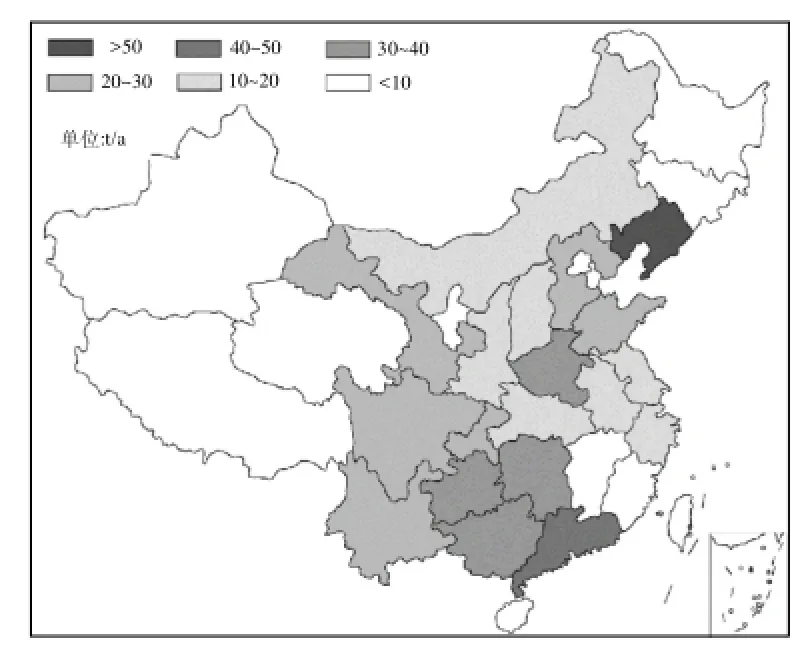
图1 中国各省份人为源排放汞量[4]Fig.4 Anthropogenic emissions of mercury by province in China
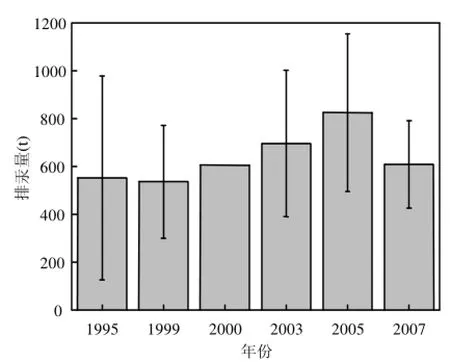
图2 中国人为源向大气汞排放量[3-8]Fig.4 Anthropogenic mercury emissions into the atmosphere in China
1.1.1煤炭燃烧 Feng等[10]估算在1994年,来自人为源的燃煤汞排放量大约为296t;Wang等[11]认为,中国在1995年通过煤炭燃烧向大气排汞量为 214t,并以每年 4.8%的速度增加; Wu等[5]和Pirrone等[12]的研究表明,在 2003年煤炭燃烧向大气排放汞量大约为 256~268t,占中国总人为源排放的40%左右.这些估算存在着较大差异,原因主要是煤炭的汞浓度估计造成的,煤炭汞浓度对估算燃煤汞排放量具有重要影响.Wang等[11]和Zhang等[13]使用0.22mg/kg作为全国煤炭汞平均浓度;其他的一些研究分别以 0.15mg/kg[14]和0.16mg/kg[15]作为平均浓度;美国地质调查局[16]分析了全国所有省市的305个样品,得到的中国平均汞浓度为 0.16mg/kg;Zheng 等[17]总结了前人研究的 1699个样品的研究结果,并以0.19mg/kg作为全国煤炭汞平均浓度;Tian等[18]也通过总结之前的研究认为全国平均煤炭汞浓度范围在 0.18~0.20mg/kg;最近一次的对全国煤炭汞浓度的估算为0.17mg/kg[19].
另外,影响燃煤汞排放的还有煤炭燃烧过程中的空气污染控制装置,Wang等[20]研究了中国6个典型火电厂,发现空气污染控制装置对汞的去除效率达到73%,Zhou等[21]研究表明燃煤小锅炉在按照脱硫装置后,汞的排放量也可以降低23%~86%.赋存在燃煤中的汞经过燃烧后几乎所有的汞会转变为 Hg0进入高温的烟气,经过各污染控制设备过程中,由于温度、烟气成分及飞灰等的影响,Hg0会发生复杂的物理化学反应而转化为不同的形态:颗粒态汞(pHg)、氧化态汞(Hg2+)以及元素态汞(Hg0).一般颗粒态汞易于被除尘器收集,Hg2+易溶于水,易于被湿法烟气脱硫装置去除,而Hg0挥发性高、不溶于水,不溶于酸,很难被除尘器去除.因此,汞的排放形态直接影响汞的脱除效率.在燃煤过程中,烟气中不同形态的汞的含量及比例主要受到煤种、锅炉的燃烧方式及燃烧温度、烟气成分、烟气中的 HCl和飞灰等因素综合作用[22].John等[23]研究表明,烟煤燃烧产生的烟气中的汞是以Hg2+为主的,亚烟煤燃烧后,烟气中的Hg2+含量与Hg0含量相当,褐煤燃烧后烟气中以Hg0为主,而且当炉膛温度较高时,烟气中Hg0含量较大,大多数的 Hg2+形成的氧化物不稳定,会发生分解生成单质汞,当烟气温度降低于750K时,烟气中汞主要以Hg2+形式存在;另外,烟气成分也会影响 Hg0的氧化作用,由于烟气成分的复杂性,烟气中可能含有促进烟气中的零价汞氧化的物质存在,使汞形态发生变化;同时研究还表明,含氯物质有利于Hg2+的形成,这可能是烟气中的氯将 Hg0氧化的结果[22].因此,将烟气中的Hg0转化为Hg2+和PHg更有利于烟气中汞的去除,实施除尘器平均除汞效率为23%,静电除尘器效率为 29%,静电除尘和湿式烟气脱硫装置连用去除效率为 60%~70%,如果在静电除尘和湿式烟气脱硫装置连用基础上再加上选择性催化还原装置将烟气中的Hg0转化为Hg2+,去除效率可以到达 69%;中国燃煤电厂普遍使用的袋式除尘器装置加上湿式烟气脱硫装置对汞的去除效率可以达到最大的89%[9].
1.1.2有色金属冶炼 有色金属冶炼同样是人为源排放汞的重要组成部分,Wu等[5]估算在1995年中国有色金属冶炼向大气排汞量大约为230t,而这一数字到2003年增加到320t;Hylander 等[24]推算来自锌、铅、铜冶炼排放的汞量约为83.2t;Zhang等[9]研究表明有色金属冶炼在2000~2010年期间排放量在96.4~146.4t,与Wu[5]等在同年(2003年)研究结果相差47%,主要因为对冶炼过程中脱汞设施对汞的去除效率估算存在较大差异.在有色重金属中,锌冶炼过程中汞排放量最大[4-5],Li等[25]通过野外调查推算在2002~ 2006期间中国锌冶炼排汞量在 80.7~104.2t之间;Yin等[26]通过同位素质量分馏估算2006年中国锌冶炼排汞量与 Li等[25]研究相似,为 107.7t; 而Zhang等[9]通过现场测定估算2006年中国锌冶炼排汞量 82.3t,比之前研究结果要低[4-5],因为之前研究通过采用国际经验的单一排放因素模型来估算锌冶炼过程中汞排放,现场实测值要低于这一模型计算值.
与全球人为汞排放来源来看,中国有色金属冶炼所占比例明显高于世界上其他国家,但由于不同的冶炼方法和尾气的处置方式导致这一过程中汞的排放存在很大的不确定性,Wang等[20]对湿法锌冶炼过程中的烟气进行观测,发现大部分汞可以通过烟气处理装置而被去除,每吨锌冶炼汞排放量仅为 0.5g.另一个影响有色重金属冶炼过程中汞排放的重要因素是矿石的含汞量,与煤炭相比,矿石中汞的含量要明显高很多.Streets 等[4]指出中国锌中的汞浓度范围在1~1000mg/kg左右;Song 等[27]采集和分析了中国 208个锌矿石样品,得到中国锌中汞的几何平均浓度为9.45mg/kg;Yin等[26]发现矿石中的汞浓度取决于矿石类型和来源,并通过分析82个矿石样品得到锌矿石的几何平均浓度为7.34mg/kg;Wu 等[5]研究认为中国锌、铅、铜矿石中汞的浓度分别为9.7,10.3,2.9mg/kg.
1.1.3其他生产活动 在 1995~2003期间,黄金冶炼向大气排汞量从96t降低到45t[5],2003年大规模的黄金生产和手工与小规模的汞矿活动分别占其中的 36%和 64%.水泥生产也是大气汞的重要来源,中国水泥产量在2011年达到200亿t,占世界产量的一半,Pirrone等[12]估算这一排汞量大约为236t,要高于Wu 等[5]对2003年的估算值,这一差异的主要是因为对水泥生产过程中原材料(包括石灰岩、煤炭、黏土、矿渣等)汞浓度的估算造成的,例如,石灰岩中汞的浓度范围在0.5~ 2000µg/kg,煤炭中汞的浓度范围在5~1000µg/kg[5,12].
而世界其他国家的人为大气汞释放要远低于中国,美国在 1994~1995年期间年平均排汞量为158t[28],大约有87%的大气汞释放来自能源的燃烧(垃圾和化石燃料的燃烧),而到2000年大气汞排放总量为109.2t,有着明显的下降趋势.这种明显的下降趋势是由于在20世纪90年代美国就开始对不同的类型的火力发电厂的燃煤、烟气、燃烧过程中逐步去除汞而降低大气汞的排放,而这些脱汞设施可以大大降低燃煤过程中汞的排放;因此使得北美人为源汞释放占全球汞的3%,而美国火电厂燃煤汞排放仅占总排放量的 1%[29],因此燃煤电厂安装脱汞设施是降低大气汞的释放的重要途径.由于中国基础建设的快速发展,区别于其他国家汞排放的另一个重要特点就是水泥生产和有色金属冶炼在中国汞排放中占有很大比例[9],所以降低中国大气汞排放的另一个重点在于降低水泥生产和有色金属冶炼过程中大气汞的释放.
1.2自然源汞释放
自然源汞释放在全球汞的生物地球化学循环过程中贡献较大.Pirrone等[12]通过模型计算得出全球自然源汞年释放量在 5207t,远大于认为源汞排放源 2320t.火山爆发,森林火灾等是主要的自然汞释放来源.然而地表/大气汞交换和之前通过沉降到地表后在经过地表释放到大气中的汞是自然汞排放源的重要途径,而这一过程汞的排放过程非常复杂,通常受到气象条件(温度、辐射、风速、湿度等),土壤自身条件(温湿度、汞浓度、土壤类型、pH、有机质等),大气汞浓度等诸多条件影响.
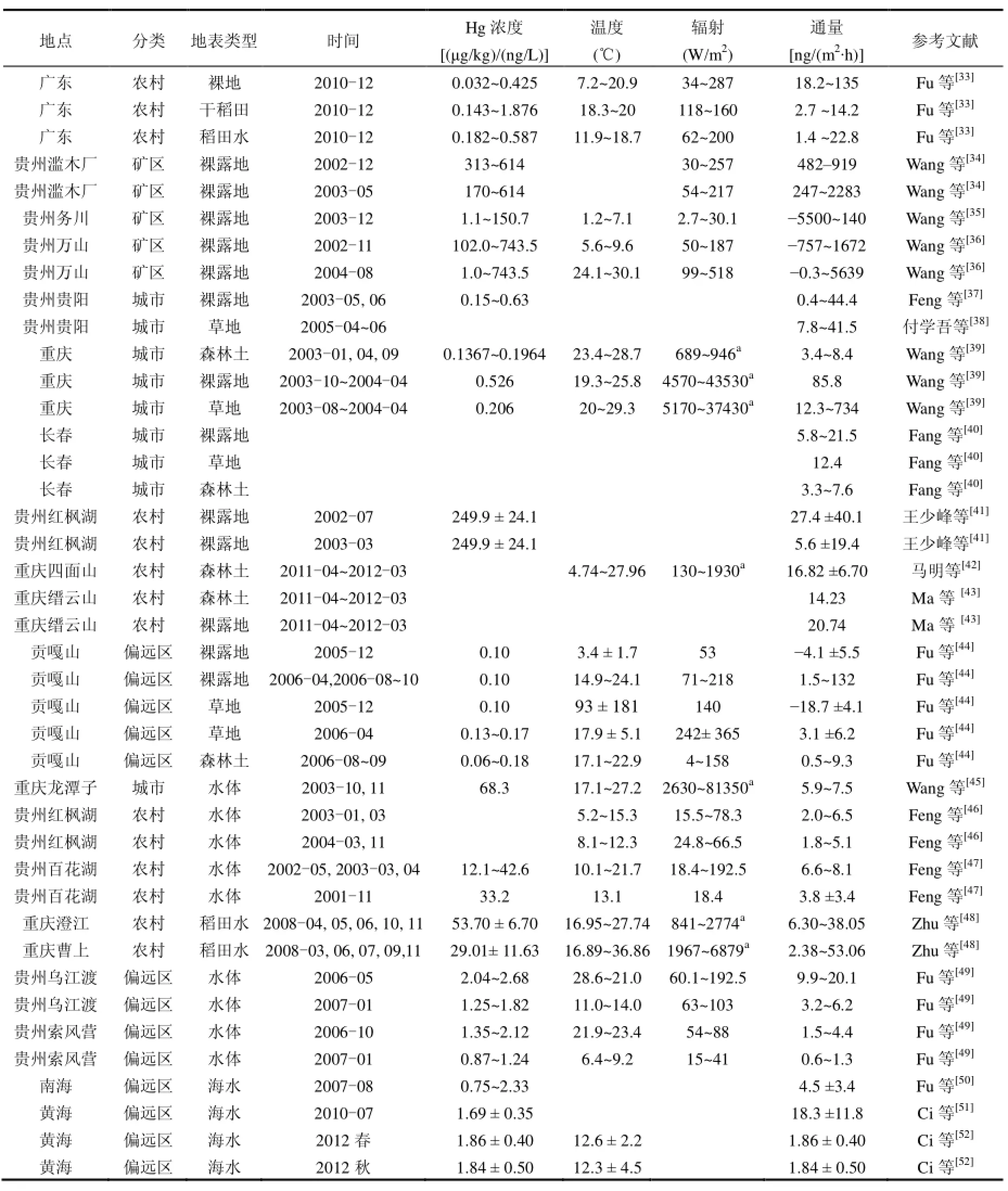
表1 中国自然地表/大气汞通量研究汇总Table 1 Statistic summary of mercury fluxes from natural surfaces in China
表1总结了中国不同类型地表/大气汞交换的研究结果.通过这些研究,可以得到以下研究结论:(1)地表和大气之间汞交换是双向的,但是总的来说土壤主要向大气释放,大气向土壤沉降往往在温度和辐射较低的冬季发生或大气汞浓度升高抑制了土壤的释放[30-37];(2)中国地表/大气汞交换要远比欧洲和北美大,在北美背景区裸露地表/大气汞交换通量在0.1~2.7ng/(m2∙h),加拿大水体和森林土壤汞的释放通量在0~5ng/(m2∙h)和-0.4~2.2ng/(m2∙h)[32],导致这一原因可能是中国土壤汞浓度较高和大气汞沉降较大,沉降到地表后的汞又被重新释放到大气中.(3)不同地表汞释放通量差别较大,城市和裸露地汞释放通量较大,而偏远地区和被植被覆盖的草地、森林以及水体汞释放通量较小.(4)具有明显的季节性变化,夏季地表/大气汞交换通量较大,冬季较小,主要是由大气温度和太阳辐射的影响.
一些通过野外和模型估算地表向大气排放汞通量研究指出,地表汞释放占全球汞排放相当大的比例,Shetty等[53]指出中国通过地表向大气排放的汞在2001年达到462t,占人为源的80%左右(575t).Pan等[54]估算中国每年向大气排放1140t汞,其中565t是来自自然源.因此这些研究基本上都认为,中国人为源汞排放与自然源汞排放水平相当,但是自然源汞排放受到的影响条件较多,当前对自然源汞排放往往是通过经验主义模型估算的,不确定性远远大于人为源汞排放.
通常情况下,中国巨大的自然源汞排放要远远高于北美和欧洲等国家的自然源的汞释放,当前报道的美国背景区土壤/大气汞平均交换通量在 0.1~2.7ng/(m2∙h),加拿大水体环境和森林土壤汞的交换通量分别~5,-0.4~2.2ng/(m2∙h)[55].中国自然源的土壤和水体的较高的汞排放通量可能是由以下原因造成的,(1)首先中国的通量研究通常是在污染区进行测定的,较高的土壤汞浓度使得排放通量的增加;(2)中国较高的大气汞沉降通量使得沉降到地表的大气汞重新释放到大气中;(3)不同的通量实验测定方法和实验参数造成地表较高的大气汞排放.
2 大气汞形态和浓度分布
2.1城市地区和工业区大气汞分布
中国大气汞浓度分布有着明显的空间分布特征,在城市和工业区总气态汞(TGM)浓度变化范围在 2.7~35ng/m3,是北美和欧洲所报道的1.5~7倍左右[56-57].在中国沿海地区,例如上海、宁波和厦门 TGM 浓度较低,分别为(2.7±1.7), (3.79±1.29)和(3.50±1.21)ng/m3(图3),可能是相对清洁的海洋气流影响.与之相比,内地城市观测到较高的 TGM浓度,可能原因是这些城市有较多的工业区和火电厂等人为汞排放源.与中国紧邻的韩国和日本相比,中国内地 TGM浓度都相对较高,例如Kim等[58]报道首尔的TGM、PHg和RGM浓 度 分 布 为 (3.22±2.10)ng/m3,(23.9± 19.6)pg/m3和(27.2±19.3)pg/m3;Osawa等[59]观测了日本内地城市的TGM浓度为3.78ng/m3;而在美国密尔沃基观测到的大气汞浓度更低,GEM、PHg和 RGM 浓度分布为(2.48±0.02)ng/m3, (11.8±0.31)pg/m3和(10.3±0.2)pg/m3[60].
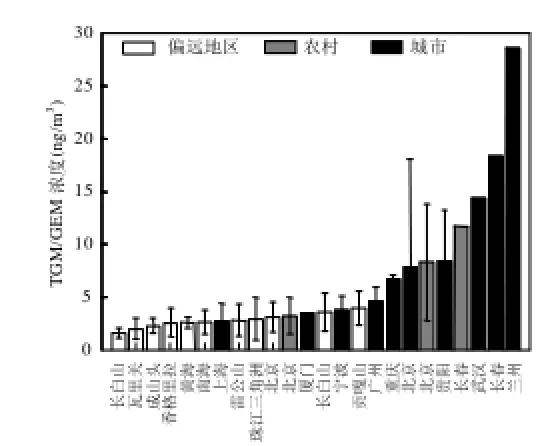
图3 中国不同区域大气TGM浓度分布[40,61-77]Fig.4 TGM concentrations distribution in the atmosphere in different regions of China
中国城市PHg浓度范围在109~1180pg/m3,占城市大气汞浓度的10%左右.Valente等[78]总结了世界上所报道的城市,农村和偏远地区大气汞形态浓度的分布发现,北美和欧洲大气PHg汞浓度一般低于100pg/m3.中国城市地区的RGM研究较少,贵阳和厦门 RGM 浓度分别为(35.7± 43.9)pg/m3和(61.05±69.41)pg/m3(表2).中国城市和工业地区高浓度的大气形态汞说明该区域是大气汞的重要来源,城市地区是中国人口的集中地,大量的能源消耗和工业生产成为重要的大气汞源.而这些区域大气汞释放也成为了周边地区大区汞污染的重要源,城市周边地区也观测到较高的TGM浓度(图3).
2.2偏远地区大气汞分布
在中国偏远地区观测到的大气TGM浓度一般都比北半球大气 TGM 背景值要高(1.5~ 1.7ng/m3)[12],除Fu等[64]在长白山观测到的TGM(1.60±0.51ng/m3),其中贡嘎山观测到的大气汞浓度最高,为(3.98±1.62)ng/m3(图 3),主要来自当地居住的人为的煤炭燃烧和该地区的有色金属冶炼导致的.而这一原因导致的大气汞浓度升高在中国其他地区普遍发生,因为没有有效政策和法律约束这一行为,而且分散的家庭煤炭和生物质燃烧汞的释放因子远比火电厂和锅炉燃煤要高[4,79].Wan等[63,80]对中国北方温度森林长白山地区大气形态汞为期一年的观测发现,大气的 TGM,PHg和 RGM 浓度分别为(3.58± 1.78)ng/m3,(77±136)pg/m3,(65±84)pg/m3,浓度都高于北半球的背景值[12].由于RGM和PHg不能长距离迁移,所以可能主要由当地的汞污染所造成的,由Fu等[56]在该区域不同点连续观测TGM浓度的研究可以证明这一点,该研究连续两年观测发现 TGM 浓度只有(1.60±0.51)ng/m3,与北半球TGM浓度相当.
Fu等[65]在雷公山观测得到的TGM浓度为(2.80±1.51)ng/m3,也高于背景值,可能由于西南地区较高的土壤汞背景浓度和加上贵州人为源的排放造成的.在我国西北地区的瓦里关全球大气观测基准站观测到的TGM,PHg和RGM浓度分 别 为 (1.98±0.98)ng/m3,(19.4±18.1)pg/m3和(7.4±4.8)pg/m3[67],比高于欧洲和北美地区的背景值[81-82],周边的一些大城市,比如西宁、西安和兰州等可能是其主要的汞来源.
2.3大气汞浓度的地理分布
通过已有的模型和观测可以看出,中国大气汞浓度分布有着明显的地理空间分布特征[83-88], Lin等[88]通过模型模拟了东亚地区大气汞的浓度分布,发现该区域内大气汞浓度分布有 2个主要的特征,一是大气汞浓度分布的空间格局类似天然来源的排放量[53],但是不同的是大的汞释放源附近有着较高的大气汞浓度,在中国大的汞释放源占人为源汞排放的 45%[88],大的汞释放源点主要来自煤炭和和锌和铅的冶炼,因此像辽宁、河北、广东、贵州、甘肃等人为源排放较大的省份相应的也有较高的大气汞浓度,与自然源和区域源相反的是,大的汞释放源因为具有较高的温度,所以可以进入高层大气和长距离传输,同时也造成周边大气汞污染.另一个特点是由于人为源造成较高大气汞浓度的内地省份,包括辽宁、北京、河北、山西、安徽、湖北、江西、湖南、贵州、广西、广东等地,向太平洋和中国的西部地区有着明显的浓度梯度,表明中国大陆在冬季的西北季风和夏季的东南季风将人为源排放的汞向太平洋和中国的西部地区有着明显的传输作用.
所要指出的是通过以上模型估算我国中部和西南的大气GEM浓度一般在2.0~2.5ng/m3,要比实际观测值低很多,PHg也要实际观测值要低, 而 RGM浓度比实测值要高,造成这种的原因有很多,首先由于地理区域的汞背景值有较大差异,例如在贵州省,较高的土壤汞背景值使贵阳市大气汞浓度明显高于其他相似人为源排放的地区[74];另外当前观测受到当地和区域汞源释放的影响,使得实测值高估了区域的大气形态汞的背景值;在现有的估算清单和排放模型中具有很大的不确定性,有可能低估了或漏估了某些汞释放源[85,88-92].
3 大气汞沉降
3.1城市地区大气汞沉降
中国城市和城市郊区降雨浓度和大气汞湿沉降量分别在55.3~354ng/L和77.6~152 μg/(m2∙a)之间(表2),明显比美国城市和工业地区观测到的降雨浓度和湿沉降量大很多[80-82].中国东北地区长春市降水汞浓度特别高,这与该城市严重的汞污染有关,降水中的汞浓度主要来自大气中RGM和PHg[1],从表2可以看出长春市的PHg浓度很高,造成了雨水中汞浓度也很高.
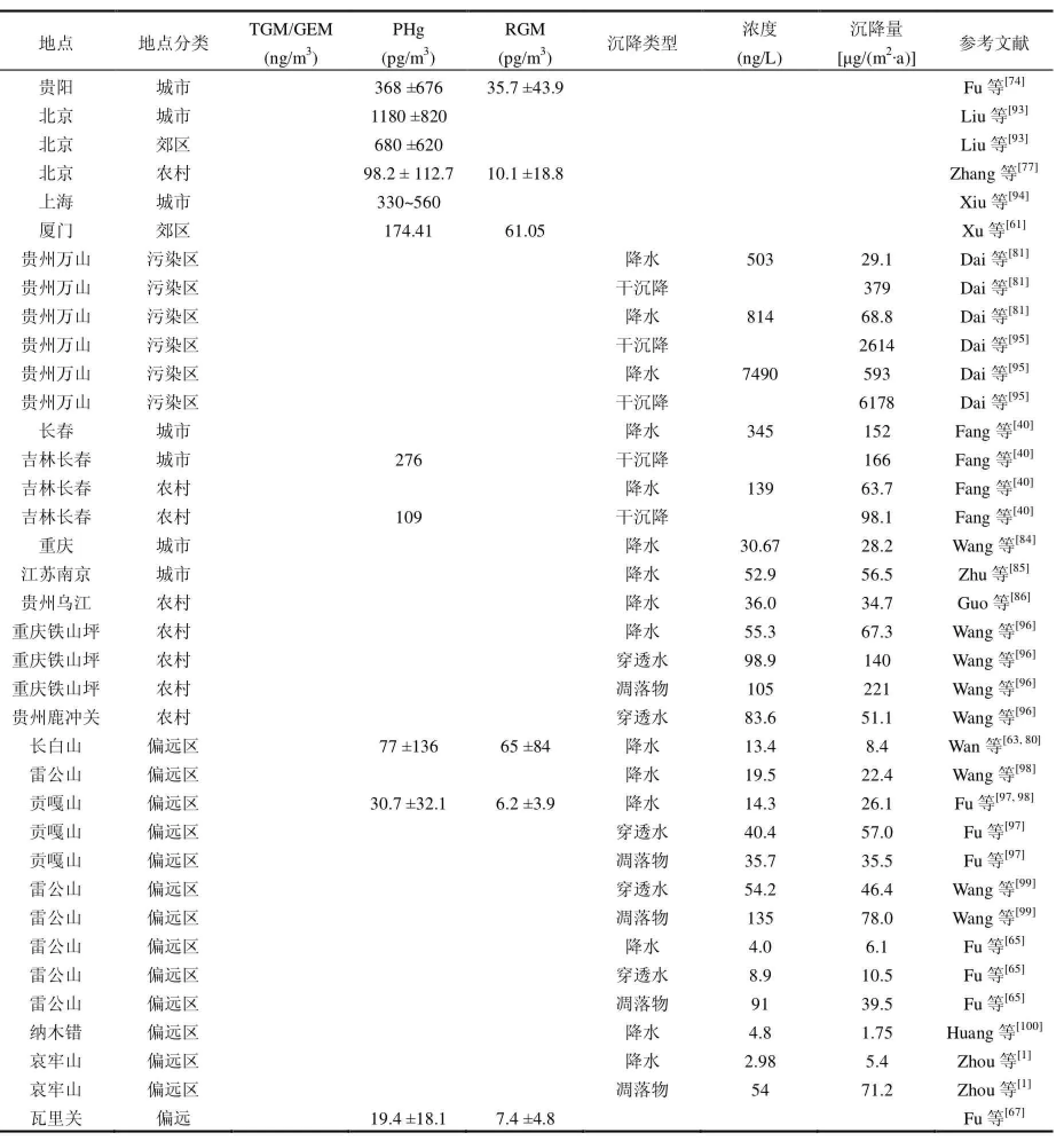
表2 中国大气PHg和RGM浓度和汞沉降研究统计汇总Table 1 Statistic summary of atmospheric Hg deposition fluxes in China
3.2偏远地区大气汞沉降
与城市地区的降水汞浓度和湿沉降量相比,中国半偏远地区和偏远地区的降水浓度和沉降量明显降低,分别在 2.98~34ng/L和 5.4~34.7μg/ (m2∙a)之间(表 2).Zhou等[1]在云南哀牢山研究发现降水汞浓度年平均值为 2.98ng/L,为观测到的降水浓度汞的最低值,原因是该地区远离人为汞的污染源,相对清洁.但总体来说,中国半偏远地区和偏远地区的降水浓度和沉降量要比北美类似地区的要高,北美的降水浓度一般小于10ng/L,湿沉降量小于 10μg/(m2∙a)[101-103],主要原因是中国大量的人为源汞排放到大气中,不仅造成污染附近大量的沉降(城市地区),而且这些汞通过长距离迁移到达偏远地区,造成我国偏远地区的污染,而在北美和欧洲较低的人为源汞排放使得偏远地区大气汞沉降量也较低[104-106].
3.3大气汞干沉降
除去大气汞湿沉降以外的沉降为干沉降,在林冠层覆盖区一般包括穿透水沉降部分减去湿沉降部分,和凋落物汞沉降.Wang等[98]和 Fu 等[65,97]收集了铁山坪、贡嘎山和雷公山地区的降水、穿透水和凋落物,通过计算得出三个区域的干沉降通量分别为256, 66.4和44μg∙m-2∙yr-1,在森林覆盖地区大气汞干沉降是湿沉降的 2.54~ 7.3倍.同时与北美和欧洲相比中国大气汞干沉降明显较高[104-106].这要归因于中国大气较高的TGM,PHg和RGM浓度,而这些高浓度的污染物主要来自人为源的排放和沉降到地表后又经过地表排放进入到大气[107].
4 结论
4.1中国来自人为活动排放的汞量大约为500~700t/a,占世界人为源排汞量的25%~30%.然而,自然源排放的不确定性更大,自然源汞排放是中国向大气排放的重要组成部分,占人为源的80%左右.通常情况下,中国裸露地、植被覆盖地和水面汞释放要比北美和欧洲这些自然源汞排放量要大很多,这要部分的归因于之前大量的汞沉降到地表后,在次释放到大气中.
4.2与国外相比,中国不管是城市、郊区、农村和偏远地区大气中TGM和PHg浓度都要明显高于北美和欧洲地区,尤其是城市地区,而这些污染的来源主要是来自当地人类生产和生活对能源和自然资源的消耗,并通过大气的长距离迁移传送到偏远地区.中国背景区的大气汞沉降与发达国家相比要高1~2倍左右,而在城市地区大气汞沉降是北美和欧洲的1~100倍左右.
[1] Zhou J, Feng X, Liu H et al. Examination of total mercury inputs by precipitation and litterfall in a remote upland forest of Southwestern China [J]. Atmospheric Environment, 2013,81:364-372.
[2] Schroeder W H, Beauchamp S, Edwards G, et al. Gaseous mercury emissions from natural sources in Canadian landscapes [J]. Journal of Geophysical Research, 2005,110:D18302.
[3] Hu D, Zhang W, Chen L, et al. Mercury emissions from waste combustion in China from 2004 to 2010 [J]. Atmospheric Environment, 2012,62:359-366.
[4] Streets D G, Hao J M, Wu Y, et al. Anthropogenic mercury emission in China [J]. Atmospheric Environment, 2005,39:7789-806.
[5] Wu Y, Wang S X, Streets D G, et al. Trends in anthropogenic mercury emissions in China from 1995 to 2003 [J]. Environmental Science and Technology, 2006,40:5312-5318.
[6] Lindberg S E, Bullock R, Ebinghaus R, et al. A synthesis of progress and uncertainties in attributing the sources of mercury in deposition [J]. Ambio, 2007,36:19-32.
[7] Schroeder W H, Munthe J. Atmospheric mercury-An overview [J]. Atmospheric Environment, 1998,32(5):809-822.
[8] Pacyna E G, Pacyna J M, Steenhuisen F, et al. Global anthropogenic mercury emission inventory for 2000 [J]. Atmospheric Environment, 2006,40:4048-4063.
[9] Zhang L, Wang S, Wang L, et al., Updated Emission Inventories for Speciated Atmospheric Mercury from Anthropogenic Sources in China [J]. Environmental Science & Technology, 2015,49(5): 3185-3194.
[10] Feng X B, Hong Y T. Estimation of mercury released to the air from coal combustion in China [J]. Coal Mine Environment Protection, 1996,10(3):10-13.
[11] Wang Q, Shen W, Ma Z. Estimation of mercury emission from coal combustion in China [J]. Environmental Science and Technology, 2000,34(13):2711-2713.
[12] Pirrone N, Cinnirella S, Feng X, et al. Global mercury emissions to the atmosphere from anthropogenic and natural sources [J]. Atmospheric Chemistry and Physics, 2010,10:5951-5964.
[13] Zhang M Q, Zhu Y C, Deng R W. Evaluation of mercury emissions to the atmosphere from coal combustion, China [J]. Ambio, 2002,31(6):482-484.
[14] Huang W, Yang Y. Mercury in coal in China [J]. Coal Geology of China, 2002,14(5):37-40.
[15] Zhang J, Ren D, Xu D, et al. Mercury in coal and its effect on environment [J]. Advances in Environmental Science, 1999,7(3): 100-104.
[16] United States Geological Survey (USGS) [R]. Washington D.C.: Mercury Content in Coal Mines in China. 2004.
[17] Zheng L, Liu G, Chou C L. The distribution, occurrence and environmental effect of mercury in Chinese coals [J]. Science of the Total Environment, 2007,384(1-3):374-383.
[18] Tian H Z, Wang Y, Xue Z G, et al. Trend and characteristics of atmospheric emissions of Hg, As, and Se from coal combustion in China, 1980-2007 [J]. Atmospheric Chemistry and Physics, 2010,10(23):11905-11919.
[19] Zhang L, Wang S X, Meng Y, et al. Influence of mercury and chlorine content of coal on mercury emissions from coal-fired power plants in China [J]. Environmental Science and Technology, 2012,46(11):6385-6392.
[20] Wang S X, Zhang L, Li G H, et al. Mercury emission and speciation of coal-fired power plants in China [J]. Atmospheric Chemistry and Physics, 2010,10(3):1183-1192.
[21] Zhou J, Zhang L, Luo Z, et al. Study on mercury emission and its control for boiler of 300 MW unit [J]. Thermal Power Generation, 2008,37(4):22-27.
[22] 盘思伟,胡将军,唐 念,等.燃煤电厂烟气汞的排放及控制研究[J]. 环境科学与管理, 2014,39(4):100-103.
[23] John H Pavlish, Michael J Holmes, Steven A Benson, et al. Application of sorbents for mercury control for utilities burning lignite coal [J]. Fuel Processing Technology, 2004,85(4):563-576.
[24] Hylander L D, Herbert R B. Global emission and production of mercury during the pyrometallurgical extraction of nonferrous sulfide ores [J]. Environmental Science and Technology, 2008, 42(16):5971-5977.
[25] Li G H, Feng X B, Li Z G, et al. Mercury emission to atmosphere from primary Zn production in China [J]. Science of the Total Environment, 2010,408(20):4607-4612.
[26] Yin R S, Feng X B, Li Z G, et al. Metallogeny and environmental impact of Hg in Zn deposits in China [J]. Applied Geochemistry, 2012,27(1):151-160.
[27] Song J X, Wang S X, Li G H. Spatial distribution of mercury content of zinc concentrates in China [J]. Science Paper Online, 2010,5(6):472-475.
[28] USEPA. Mercury Study Report to Congress [M]. Volume I: Executive Summary, 0-1.
[29] Seigneur C, Vijayaraghavan K, Lohman K, et al. Modeling the atmospheric fate and transport of mercury over North America: power plant emission scenarios [J]. Fuel Processing Technology, 2004,85:441-450.
[30] Corbett-Hains, H., Walters, N.E., Heyst, B.J.V., 2012. Evaluating the effects of sub-zero temperature cycling on mercury flux from soils [J]. Atmospheric Environment, 63,102-108.
[31] Mazur, M., Mitchell, C.P.J., Eckley, C.S., et al. Gaseous mercury fluxes from forest soils in response to forest harvesting intensity: A field manipulation experiment [J]. Science of the Total Environment 2014,496,678-687.
[32] Ericksen J A, Gustin M S, Xin M, et al. Air-soil exchange of mercury from background soils in the United States [J]. Science of the Total Environment, 2006,366:851-863.
[33] Fu X, Feng X, Zhang H, et al. Mercury emissions from natural surfaces highly impacted by human activities in Guangzhou province, South China [J]. Atmospheric Environment, 2012,54: 185-193.
[34] Wang SF, Feng X B, Qiu G L, et al. Mercury emission to atmosphere from Lanmuchang Hg-Tl mining area, Southwestern Guizhou, China [J]. Atmospheric Environment, 2005,39:7459-7473.
[35] Wang SF, Feng X B, Qiu G L, Shang L H, et al. Mercury concentrations and air/soil fluxes in Wuchuan mercury mining district, Guizhou province, China [J]. Atmospheric Environment, 2007,41:5984-5993.
[36] Wang SF, Feng X B, Qiu G L, et al. Characteristics of mercury exchange flux between soil and air in the heavily air-polluted area, eastern Guizhou, China [J]. Atmospheric Environment, 2007, 41:5584-5594.
[37] Feng X, Wang S F, Qiu G L, et al. Total gaseous mercury emissions from soil in Guiyang, Guizhou, China [J]. Journal of Geophysical Research, 2005,110:D14306.
[38] 付学吾,冯新斌,王少锋,等.贵阳市 2种不同类型草地的汞释放通量 [J]. 环境科学研究, 2007,20(6):33-37.
[39] Wang D Y, He L, Wei S Q. Estimation of mercury emission from different sources to atmosphere in Chongqing, China [J]. Science of the Total Environment, 2006,336:722-728.
[40] Fang F M, Wang Q C, Li J F. Urban environmental mercury in Changchun, a metropolitan city in Northeastern China: source, cycle, and fate [J]. Science of the Total Environment, 2004,330: 159-170.
[41] 王少锋,冯新斌,仇广乐,等.夏季红枫湖地区农田土壤—大气界面汞交换通量的初步研究 [J]. 矿物岩石地球化学通报, 2004, 23(1):19-23.
[42] 马 明,王定勇,申源源,等.中亚热带针阔混交林土壤-大气界面释汞通量研究 [J]. 环境科学, 2014,35(1):85-92.
[43] Ma M, Wang D, Sun R, et al. Gaseous mercury emissions from subtropical forested and open field soils in a national nature reserve, southwest China [J]. Atmospheric Environment, 2013,64: 116-123.
[44] Fu X W, Feng X B, Wang S F. Exchange fluxes of Hg between surfaces and atmosphere in the eastern flank of Mount Gongga, Sichuan province, southwestern China [J]. Journal of Geophysical Research, 2008,113:D20306.
[45] Wang D Y, He L, Wei S Q. Estimation of mercury emission from different sources to atmosphere in Chongqing, China [J]. Science of the Total Environment, 2006,336:722-728.
[46] Feng X, Wang S, Qiu G L, et al. Total gaseous mercury exchange between water and air during cloudy weather conditions over Hongfeng Reservoir, Guizhou, China [J]. Journal of Geophysical Research, 2008,113:D15309.
[47] Feng X, Yan H Y, Wang S F, et al. Seasonal variation of gaseousmercury exchange rate between air and water surface over Baihua reservoir, Guizhou, China [J]. Atmospheric Environment, 2004,38: 4721-4732.
[48] Zhu J, Wang D, Ma M. Mercury release flux and its influencing factors at the air-water interface in paddy field in Chongqing, China [J]. Chinese Science Bulletin, 2013,58:266-274.
[49] Fu XW, Feng XB, Wan Q, et al. Probing Hg evasion from surface waters of two Chinese hyper/meso-eutrophic reservoirs [J]. Science of the Total Environment, 2010,408:5887-5896.
[50] Fu X W, Feng X B, Zhang G, et al. Mercury in the marine boundary layer and seawater of the South China Sea: concentrations, sea/air flux, and implication for land outflow [J]. Journal of Geophysical Research, 2010,115:D06303.
[51] Ci Z J, Zhang X S, Wang Z W, et al. Distribution and air-sea exchange of mercury (Hg) in the Yellow Sea [J]. Atmospheric Chemistry and Physics 2011,11:2881-2892.
[52] Ci Z, Wang C, Wang Z, et al. Elemental mercury (Hg(0)) in air and surface waters of the Yellow Sea during late spring and late fall 2012: Concentration, spatial-temporal distribution and air/sea flux [J]. Chemosphere, 2015,119:199-208.
[53] Shetty S K, Lin C J, Streets D G et al. Model estimate of mercury emission from natural sources in East Asia [J]. Atmospheric Environment, 2008,42(37):8674-8685.
[54] Pan L, Chai T F, Carmichael G R, et al. Top-down estimate of mercury emissions in China using four-dimensional variational data assimilation [J]. Atmospheric Environment, 2007,41(13): 2804-2819.
[55] Schroeder WH, Beauchamp S, Edwards G, et al. Gaseous mercury emissions from natural sources in Canadian landscapes. Journal of Geophysical Research, 2005,110:D18302.
[56] Carpi A, Chen YG. Gaseous elemental mercuryfluxes in New York city [J]. Water Air Soil & Pollution, 2002,140:371-379.
[57] Stamenkovic J, Lynam S, Gustin M S. Seasonal and diel variation of atmospheric mercury concentrations in the Reno (Nevada, USA) airshed [J]. Atmospheric Environment, 2007,41:6662-6672.
[58] Kim S H, Hang Y J, Hosen T M et al. Characteristics of atmospheric speciated mercury concentrations (TGM, Hg (II) and Hg (p)) in seoul, Korea [J]. Atmospheric Environment, 2009,43: 3267-3274.
[59] Osawa T, Ueno T, Fu F. Sequential variation of atmospheric mercury in Tokai-mura, seaside area of eastern central Japan [J]. Journal of Geophysical Research, 2007,112:D19107.
[60] Rutter A P, Schauer J J, Lough G C, et al. A comparison of speciated atmospheric mercury at an urban center and an upwind rural location [J]. Journal of Environmental Monitoring, 2008,10: 102-108.
[61] Xu L, Chen J, Yang L, et al. Characteristics and sources of atmospheric mercury speciation in a coastal city, Xiamen, China [J]. Chemosphere, 2015,119:530-539.
[62] 王章玮,张晓山,张 逸,等.北京市大气颗粒物PM2.5, PM10及降雪中的汞 [J]. 环境化学, 2004,23(6):668-673.
[63] Wan Q, Feng X B, Julia L, et al. Atmospheric mercury in Changbai Mountain area, northeastern China-Part1: the seasonal distribution pattern of total gaseous mercury and its potential sources [J]. Environmental Research, 2009,109:201-206.
[64] Fu X W, Feng X B, Shang L H, et al. Two years of measurements of atmospheric total gaseous mercury (TGM) at a remote site in Mt. Changbai area, Northeastern China [J]. Atmospheric Chemistry and Physics, 2012,12(9):4215-4226.
[65] Fu X W, Feng X B, Dong Z Q, et al. Atmospheric gaseous elemental mercury (GEM) concentrations and mercury depositions at a high-altitude mountain peak in south China [J]. Atmospheric Chemistry and Physics, 2010,10(5):2425-2437.
[66] Fu X W, Feng X B, Zhang G, et al. Mercury in the marine boundary layer and seawater of the South China Sea: Concentrations, sea/air flux, and implication for land outflow [J]. Journal of Geophysical Research, 2010,115(D6):6303.
[67] Fu X W, Feng X B, Liang P, et al. Temporal trend and sources of speciated atmospheric mercury at Waliguan GAW station, Northwestern China [J]. Atmospheric Chemistry and Physics, 2012,12(4):1951-1964.
[68] Ci Z J, Zhang X S, Wang Z W, et al. Atmospheric gaseous elemental mercury (GEM) over a coastal/rural site downwind of East China: Temporal variation and long-range transport [J]. Atmospheric Environment, 2011,45(15):2480-2487.
[69] Ci Z J, Zhang X S, Wang Z W, et al. Distribution and air-sea exchange of mercury (Hg) in the Yellow Sea [J]. Atmospheric Chemistry and Physics, 2011,11(6):2881-2892.
[70] Fu X W, Feng X B, Zhu W Z, et al. Total gaseous mercury concentrations in ambient air in the eastern slope of Mt. Gongga, South-Eastern fringe of the Tibetan plateau, China [J]. Atmospheric Environment, 2008,42(5):970-979.
[71] Feng X B, Shang L H, Wang S F, et al. Temporal variation of total gaseous mercury in the air of Guiyang, China [J]. Journal of Geophysical Research, 2004,109(D3):3303.
[72] Wang Z W, Chen Z S, Duan N, et al. Gaseous elemental mercury concentration in atmosphere at urban and remote sites in China [J]. Journal of Environmental Sciences (China), 2007,19(2):176-180.
[73] Yang Y K, Chen H, Wang D Y. Spatial and temporal distribution of gaseous elemental mercury in Chongqing, China [J]. Environmental Monitoring and Assessment, 2009,156(1-4):479-489.
[74] Fu X W, Feng X B, Qiu G L, et al. Speicated atmospheric mercury and its potential source in Guiyang, China [J]. Atmospheric Environment, 2011,45:4205-4212.
[75] Friedli H R, Arellano A F Jr, Geng F, et al. Measurements of atmospheric mercury in Shanghai during September 2009 [J]. Atmospheric Chemistry and Physics, 2011,11(8):3781-3788.
[76] Nguyen D L, Kim J Y, Shim S G, et al. Ground and shipboard measurements of atmospheric gaseous elemental mercury over the Yellow Sea region during 2007-2008 [J]. Atmospheric Environment, 2011,45(1):253-260.
[77] Zhang L, Wang S X, Wang L, et al. Atmospheric mercury concentration and chemical speciation at a rural site in Beijing, China: implication of mercury emission sources [J]. Atmospheric Chemistry and Physics, 2013,13:10505-10516.
[78] Valente R J, Shea C, Humes K L, et al. Atmospheric mercury in the Great Smoky Mountains compared to regional and global levels [J]. Atmospheric Environment, 2007,241:1861-1873.
[79] Tang S L, Feng X B, Qiu J R et al. Mercury speciation and emissions from coal combustion in Guiyang, southwest China [J]. Environmental Research, 2007,105:175-182.
[80] Wan Q, Feng X B, Julia L, et al. Atmospheric mercury in Changbai Mountain area, northeastern China II. The distribution of reactive gaseous mercury and particulate mercury and mercury deposition fluxes [J]. Environmental Research, 2009,109:721-727.
[81] Sigler J M, Mao H, Talbot R. Gaseous elemental and reactive mercury in Southern New Hampshire [J]. Atmospheric Chemistry and Physics, 2009,9:1929-1942.
[82] Engle M A, Tate M T, Krabbenhoft D P, et al. Comparison of atmospheric mercury speciation and deposition at nine sites across central and eastern North America [J]. Journal of Geophysical Research, 2010,115:D18306.
[83] Bergan TL, Gallardo L, Rodhe H. Mercury in the global troposphere: a three-dimensional model study [J]. Atmospheric Environment, 1999,33:1575-1585.
[84] Seigneur C, Karamchandani P, Lohman K, Vijayaraghavan K, Shia RL. Multiscale modeling of the atmospheric fate and transport of mercury [J]. Journal of Geophysical Research, 2001, 106:27795-27809.
[85] Li P, Chai T F, Carmichael G R, et al. Top-down estimate of mercury emissions in China using four-dimensional variational data assimilation [J]. Atmospheric Environment, 2007,41:2804-2819.
[86] Selin N E, Jacob D J, Park R J, et al. Chemical cycling and deposition of atmospheric mercury: Global constraints from observations [J]. Journal of Geophysical Research, 2007,112: D02308.
[87] Shia R L, Seigneur C, Pai P, et al. Global simulation of atmospheric mercury concentrations and deposition fluxes [J]. Journal of Geophysical Research, 1999,104:23747-2360.
[88] Lin C J, Li P, Street D G, et al. Estimating mercury emission outflow from East Asia using CMAQ-Hg [J]. Atmospheric Chemistry and Physics, 2010,10:1853-1864.
[89] Friedli H R, Radke L F, Prescott R, et al. Mercury in the atmosphere around Japan, Korea, and China as observed during the 2001ACE-Asia field campaign: Measurements, distributions, sources, and implications [J]. Journal of Geophysical Research, 2004,109:D19S25.
[90] Jaffe D, Prestbo E, Swartzendruber P, et al. Export of atmospheric mercury from Asia [J]. Atmospheric Environment, 2005,39:3029-3038.
[91] Weiss-Penzias P, Jaffe D A, Swartzendruber P, et al. Quantifying atmospheric mercury emissions from biomass burning and East Asian industrial regions based on ratios with carbon monoxide in pollution plumes at the Mount Bachelor Observatory [J]. Atmospheric Environment, 2007,41:4366-4379.
[92] Choi E M, Kim S H, Holsen T M, Yi S M. Total gaseous concentrations in mercury in Seoul, Korea: local sources compared to long-range transport from China and Japan [J]. Environmental Pollution, 2009,157:816-822.
[93] Liu S L, Nadim F, Perkins C, et al. Atmospheric mercury monitoring survey in Beijing, China [J]. Chemosphere, 2002,48: 97-107.
[94] Xiu G L, Cai J, Zhang W Y, et al. Speciated mercury in size-fractionated particles in Shanghai ambient air [J]. Atmospheric Environment, 2009,43:3145-31554.
[95] Dai Z H, Feng X B, Sommar J, et al. Spatial distribution of mercury deposition fluxes in Wanshan Hg mining area, Guizhou Province, China [J]. Atmospheric Chemistry and Physics, 2012, 12(14):6207-6218.
[96] Wang Y M, Wang D Y, Meng B. Spatial and temporal distributions of total and methyl mercury in precipitation in core urban areas, Chongqing, China [J]. Atmospheric Chemistry and Physics, 2012,12:9417-9426.
[97] Fu X W, Feng X B, Zhu W Z, et al. Elevated atmospheric deposition and dynamics of mercury in a remote upland forest of Southwestern China [J]. Environmental Pollution, 2010,158: 2324-2433.
[98] Fu X W, Feng X B, Zhu W Z, et al. Total particulate and reactive gaseous mercury in ambient air on the eastern slope of the Mt. Gongga area, China [J]. Applied Geochemistry, 2008,23:408-418.
[99] Wang Z W, Zhang X S, Xiao J S, et al. Mercury fluxes and pools in three subtropical forested catchments, southwest China [J]. Environmental Pollution, 2008,157:801-808.
[100] Huang J, Kang S C, Zhang Q G, et al. Wet deposition of mercury at a remote site in the Tibetan Plateau: Concentrations, speciation, and fluxes [J]. Atmospheric Environment, 2012,62:540-550.
[101] Guentzel J L, Landing W M, Gill G A, et al. Processes influencing rainfall deposition of mercury in Florida [J]. Environmental Science and Technology, 2001,35:863-873.
[102] Landis M S, Keeler G J. Critical evaluation of a modified automatic wet-only precipitation collector for mercury and trace element determinations [J]. Environmental Science and Technology, 1997,31:2610-2615.
[103] Keeler G J, Landis M S, Norris G A, et al. Sources of mercury wet deposition in eastern Ohio. U.S.A [J]. Environmental Science and Technology, 2006,40:5874-5881.
[104] Scherbatakoy T, Shanley J B, Keeler G J. Factors controlling mercury transport in an upland forest catchment [J]. Water Air Soil & Pollution, 1998,105:427-438.
[105] St. Louis V L, Rudd W M, Kelly C A, et al. Importance of the forest canopy to flux of methylmercury and total mercury to boreal ecosystems [J]. Environmental Science and Technology, 2001,35:3089-3098.
[106] Lee Y H, Bishop K H, Menthe J. Do concepts about catchment cycling of methylmercury and mercury in boreal catchments stand the test of time? Six years of atmospheric inputs and runoff export at Svartberget, northern Sweden [J]. Science of the Total Environment, 2000,260:11-20.
[107] Zhou J, Wang Z, Zhang X, et al. Distribution and elevated soil pools of mercury in an acidic subtropical forest of southwestern China. Environmental Pollution, 2015,202:187-195.
《中国环境科学》获评“2014中国最具国际影响力学术期刊”
2014年12月,中国环境科学学会主办的《中国环境科学》被评为“2014中国最具国际影响力学术期刊”.
“中国最具国际影响力学术期刊”是《中国学术期刊(光盘版)》电子杂志社有限公司、清华大学图书馆、中国学术国际评价研究中心对我国5600余种中外文学术期刊,根据总被引频次、影响因子、被引半衰期等计算出的国际影响力综合评价指标CI进行排序,遴选出的排名前5%的期刊.获评“中国最具国际影响力学术期刊”的科技类期刊共175种.
自2012年开始此项评选以来,《中国环境科学》已连续3年获此殊荣.
《中国环境科学》编辑部
Chinese atmospheric mercury pollution status.
WU Xiao-yun1,2, ZHENG You-fei1,2*, LIN Ke-si3(1.Key Laboratory for Aerosol-Cloud-Precipitation of China Meteorological Administration, Nanjing University of Information Science and Technology, Nanjing 210044, China;2.School of Atmospheric Physics, Nanjing University of Information Science and Technology, Nanjing 210044, China;3.Nanjing Sanhe Environmental Protection Technology Co., LTD, Nanjing 210048, China).
China's economy has developed rapidly in recent decades, but it also brought the persistent pollutants of mercury emissions to the atmosphere rapidly. Mercury as a global pollutant, Chinese mercury emission has received a considerable attention internationally. Thus, this paper reviews the current understanding of and knowledge on atmospheric Hg emissions, distribution transport and deposition in China. Anthropogenic mercury annual emissions from China was the highest in the word and up to about 500~700t, which was more than 25~30% of the global anthropogenic emissions and with an annual increase rate of 4.6%. Emissions of Hg from natural surfaces (including bare soil, water, and vegetation covered soil) was comparable to anthropogenic emissions by the estimation from existing model. Atmospheric Hg exhibits a significant concentration variability among urban, semi-remote, and remote areas. Total Gaseous Mercury (TGM) concentrations in urban areas of China were often 1.5~5 folds higher compared to the corresponding settings in North America and Europe. In turn, particulate mercury (PHg) concentrations in urban areas of China were up to two orders of magnitude higher compared to North America and Europe. TGM, PHg and reactive gaseous mercury (RGM) in coastal areas and remote areas of China were lower than that in central cities, but they were still higher than the corresponding settings in North America and Europe. Accordingly, Hg deposition fluxes tended to be higher in China, with urban areas and remote areas being 1~2 magnitude and1~2 times higher than those in North America and Europe, respectively.
atmospheric mercury;emissions;distribution;deposition
X511,P421
A
1000-6923(2015)09-2623-13
2015-01-08
国家自然科学基金项目(41075114)
*责任作者, 教授, myheartwillgoonk@163.com
吴晓云(1984-),女,安徽芜湖人,讲师,博士,主要从事大气物理与大气环境方面的研究.发表论文10余篇.
